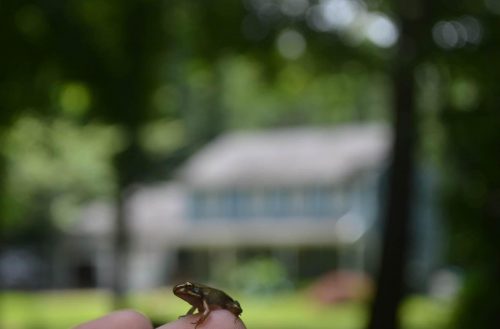Since its rise in the 1950s, suburbanization has become a defining part of American culture, with fifty-two percent of Americans living in suburbs as of 2017. Despite their popularity, these seemingly picture-perfect neighborhoods are, in reality, fraught with a long history of racial segregation, and their harmful impacts reach beyond humankind and into the natural world.
According to a recent study by a team of former Yale graduate students—Meredith C. Van Acker and Max Lambert—and current Yale School of Forestry and Environmental Studies professors—Oswald J. Schmitz and David K. Skelly—increased suburbanization correlate with a greater proportion of diseased snails and frogs. Suburbanization not only fragments wildlife habitats by breaking up previously homogenous landscapes, but it also contaminates animals’ homes with chemicals, from the pesticides in our lawns’ water runoff to the soap, detergent, and metal cations that get introduced to local bodies of water. As suburbs spread, so do the concentrations of these human-created chemicals in local ponds. These chemicals alter the chemistry of pond water in ways that may increase rates of infection, particularly by echinostomes, which are parasites that can kill green frog tadpoles.
To study the relationship between chemical contamination and echinostome infection in suburban ponds, the team investigated sixteen ponds surrounded by varying percentages of suburban land use. Since echinostomes have complex life cycles that consist of a primary freshwater snail host and a broader range of secondary hosts, including frogs and fish, the researchers collected ten metamorphic and tadpole green frogs and up to fifteen snails from each pond in order to thoroughly investigate the presence of echinostome infection throughout these host species. They also measured several factors of water quality at each pond—including pH, total dissolved solids, temperature, and conductivity—so that the prevalence of echinostome infection could be compared to water quality.
Unsurprisingly, the team found that conductivity and pH levels—which serve as measures of the concentration of metal cations and other contaminants in water—increase with suburbanization. Increased suburbanization was also shown to correlate with greater numbers of infected snails and frogs, as ponds that were surrounded by less than fifty percent of suburbs were unlikely to have infected snails. In fact, of the ponds that had snails, the only pond with snails completely unaffected by echinostome infection was the pond that was one hundred percent forested.
It has long been speculated that humans have had a hand in the increased spread of disease among wildlife, but this study reminds us just how dramatic our impact is. As suburbanization continues, we must remain mindful that the water we use is part of a larger ecosystem—that what we do may directly impact the frogs in our suburbs.

